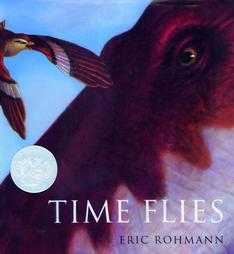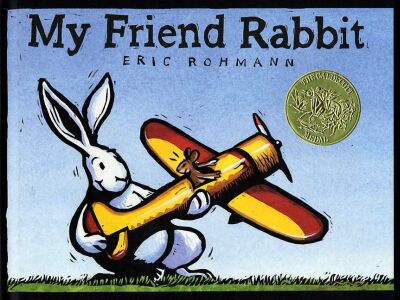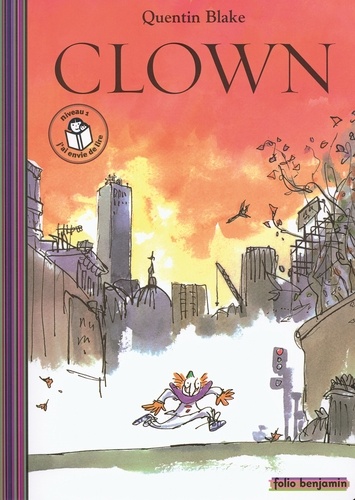You can't go wrong with any of these:
The Carl books by Alexandra Day wherein a beloved Rottweiler minds the baby, while the baby's mother gets on with her errands and her life. There's at least a dozen in the series now.

Eric Rohman's wordless or near wordless picture books:
 Time Flies depicts the journey of a bird through a prehistoric, dinosaur-laden landscape. It's a must for any dinosaur-crazed kid.
Time Flies depicts the journey of a bird through a prehistoric, dinosaur-laden landscape. It's a must for any dinosaur-crazed kid.
My Friend Rabbit should've been left alone as a book. The TV show knock-off is all talk, talk, talk. Who needs words when the pictures say it all?

Peter Spier's Noah's Ark and Rain, Raymond Briggs' The Snowman and Quentin Blake's Clown are classics in the genre,




as are Pat Hutchins' Changes Changes and a personal favourite of mine, Picnic, by Emily Arnold McCully.


Both these works have been adapted into excellent short films that have now become part of the Scholastic video collection.
More recent works include several of the books by David Wiesner. My daughter loves Tuesday, Flotsam and especially Sector 7.



There's also Australian Jeannie Baker's Window

And finally, here are two that are colour-themed:
Jae-Soo Liu's The Yellow Umbrella and Barbara Lehman's The Red Book.


There's also books like Chris van Allsburg's The Mysteries of Harris Burdick and the Imagine a Day/Night/Place books that use the paintings of Rob Gonaslaves. These books are neither wordless nor do they tell a continuous narrative; instead, they provide an evocative caption for each illustration that prompts the reader to take control of the storytelling. It's like having 10-20 individual stories per book.


There's plenty more books in the wordless genre than the ones I've listed here. Do you have a favourite? Have you read any of these with children? Did you enjoy the experience or did you find yourself awkwardly sputtering, trying to fill in the story? Do you leave them lying around for kids to stumble on? Pack them in the car for long road trips? Use them as prompts for crafts or writing assignments? Tell me. I'd like to know.
Oh, Raymond Briggs... I adore Raymond Briggs. My favourite of his isn't wordless, but it's unique - Gentleman Jim. It's done in a comic book style, but my god, it's profound and so sweet. Fantastic list! http://www.toonhound.com/briggsgj.htm
ReplyDeleteI had NO IDEA that My Friend Rabbit was a) based on a book; and b) based on a book with no talking. That amazes me. The show is so frantic and annoying... now I'm curious about the book.
ReplyDeleteMy Friend Rabbit is a BOOK? A WORDLESS BOOK? My jaw is DROPPED!
ReplyDeleteOur favorite wordless - or nearly - book: Goodnight Gorilla! HAHAHAH. It's fun.
Yes, it is near wordless. Not entirely wordless.
ReplyDeleteAnd Goodnight Gorilla is positively perfect.
so my daughter is looking at this post over my shoulder and announces, "Hey! I've read 2 Chris Van Allsburg books!"
ReplyDeletei love the snow man and Carl. i just wish our lab would watch the kids as well as he does.
good night gorilla and 10 minutes 'till bedtime are some other silent favorites in our house.
(my daughter just corrected all of my spelling in this comment!)
Wiesner, love them. Love 'most all of these in fact. It has been too long since I've visited you properly here. Seeing these is a glimpse of of old friends. Wordless books were always our favourites before bedtime & naptime ( which never really was, but the books were quiet. there was that. a delicious pause)
ReplyDeleteGood Night Gorilla is wonderful, I agree.
ReplyDeleteYes, I can't believe I didn't list those two Rathmann books. I have a reputation as Rathmann's biggest booster.
ReplyDeleteFlotsam is a favorite here, too. my daughter and I take turns telling the story as we turn the page, and I love the descriptions she comes up with.
ReplyDeleteGood Night Gorilla is a big hit, as well.
Barbara Reid's Zoe books (Zoe's Sunny Day etc.) in their original version were wordless. I was quite unhappy when I recently picked one up in a bookstore and found captions. They were so charming without words. We enjoyed making up our own stories to go along with the books.
ReplyDeleteThe Cinder-Eyed Cats is a favourite Rohmann book here.
Love the new blog. Miss the old one, but I'm happy to still find you on-line.
I was actually just given The Mysteries of Harris Burdick last week, I'm planning on using them in my reading class as part of a mysteries unit where we focus on the reading skill of using context clues. It is such a cool book!
ReplyDeleteLittle Stuff's brothers had all the Where's Aldo books. She loved them for a long time. I had to make up stories about most of the people on the page.
ReplyDeleteBut she was more into poetry than wordless books, even as a very young toddler.
I read most of these with Fiona, but I realize now that I should get them again for Lorenzo. He's right on the cusp of beginning reading - at the point where he alternates between teary frustration and pretending he can read. He spends more time than she ever did on his own looking at pictures, though I confess it's usually Batman, Transformers, and the like. (At our library, they recently took a lot of those little paperback books and put them in a bin that the kids can rummage through themselves, so the quality of the books he's selecting, at least from my perspective, has dropped considerably.)
ReplyDeleteI love Goodnight, Gorilla, and though it has words to describe half of the action, I love how Rosie's Walk leaves half of what's happening for your eyes to discover.
ReplyDelete